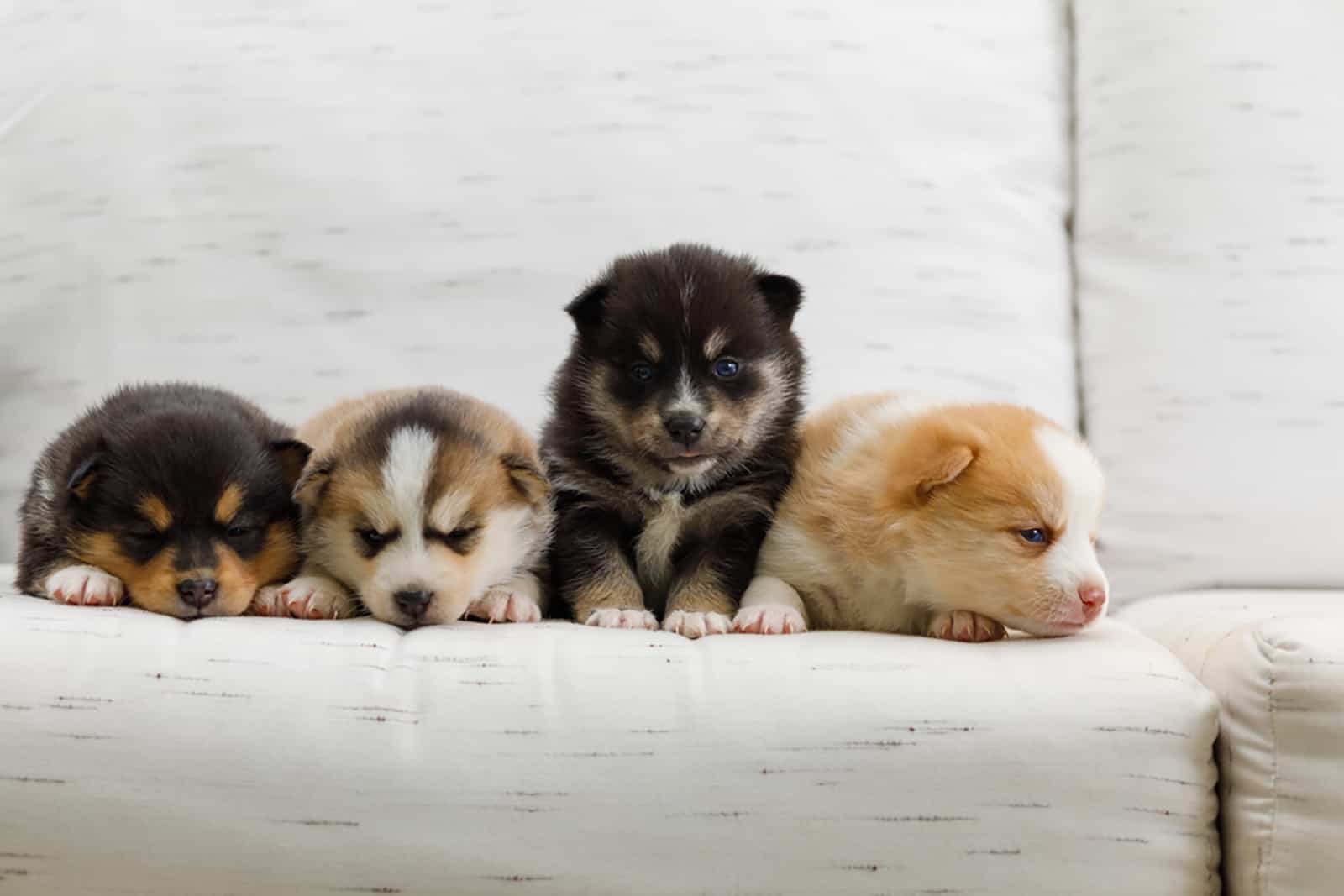The Pomsky is a crossbreed that has taken the internet by storm! Not only did this fluffy designer dog become an internet sensation, but it also became a loving family dog across the U.S.
Dog lovers are already going crazy for Pomsky’s fluffy double coat that is so irresistible, that no one can keep their hands off of it! But, what makes this double coat even more attractive is the variety of colors.
Because the Pomsky is a combination of two very colorful parent breeds, there can be over thirty Pomsky colors and it would take days to describe each shade and pattern.
We have prepared the most common and the most sought-after Pomsky colors that you will fall for!
Picking only one out of so many Pomsky colors is truly a challenge, so you better get ready!
What Is A Pomsky?
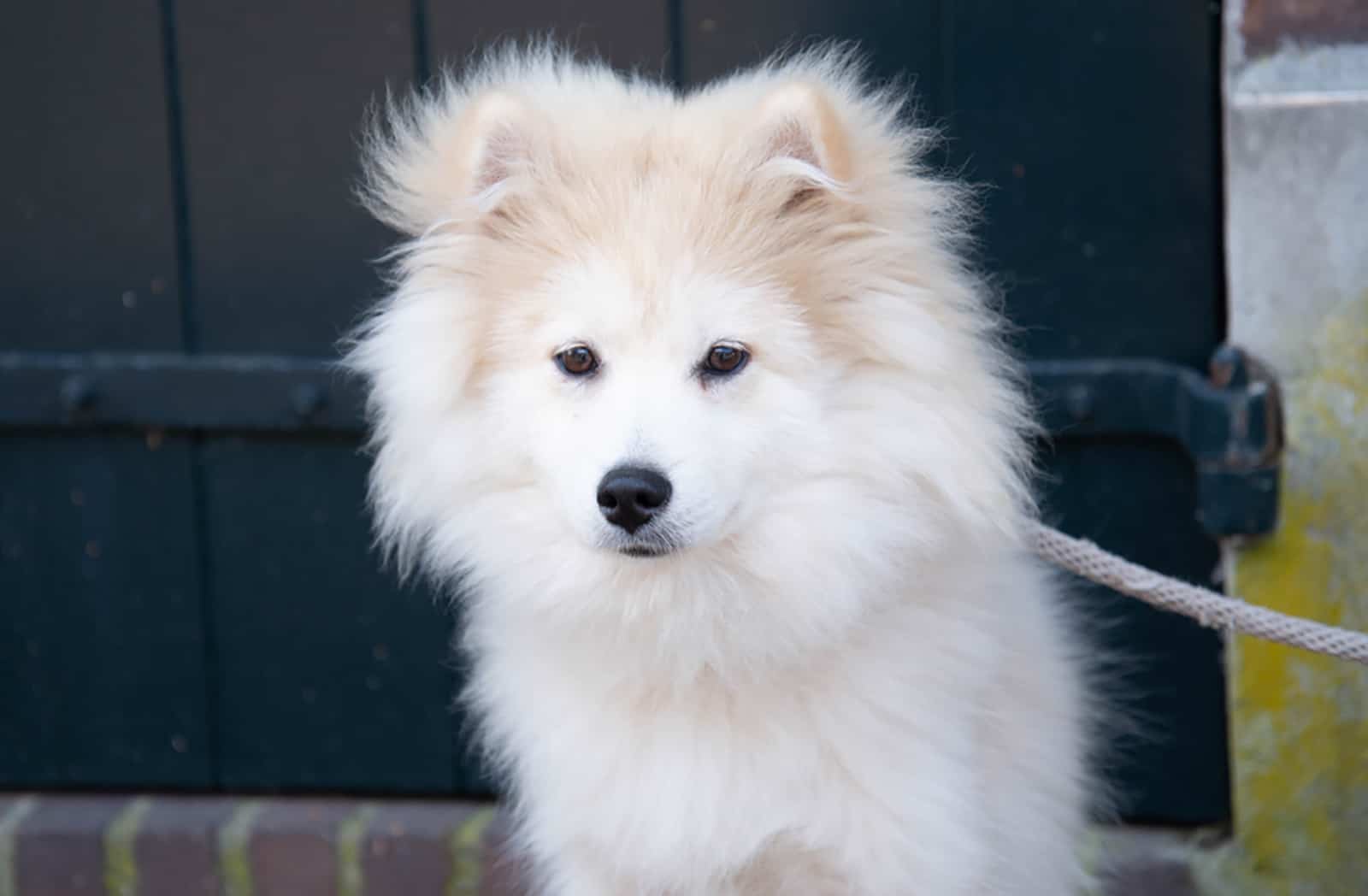
Before we begin describing some of the most interesting Pomsky colors, let’s say a thing or two about the Pomsky breed for those who haven’t heard about it.
The Pomsky is one of the fluffiest Siberian Husky mixes, to begin with. It is a designer dog whose parents are the purebred Siberian Husky and the purebred Pomeranian.
The Pomsky is undoubtedly one of the most favorable and most popular breeds in the U.S.
Each Pomsky puppy is different from one other — it resembles the Siberian Husky parent more than it resembles the Pomeranian parent and vice versa.
As a small fluffy dog breed, the Pomsky never fails to catch all the attention!
The Pomsky can be a combination of a miniature Husky and the standard Pom. But, it can also be a combination of two teacup dogs — the teacup Husky and the teacup Pomeranian. That means that the Pomsky will be a teacup mixed breed.
Even though teacup dogs look adorable, I must warn you that these dogs are often very sickly and weak due to bad breeding practices.
How Do You Tell If My Dog Is A Pomsky?
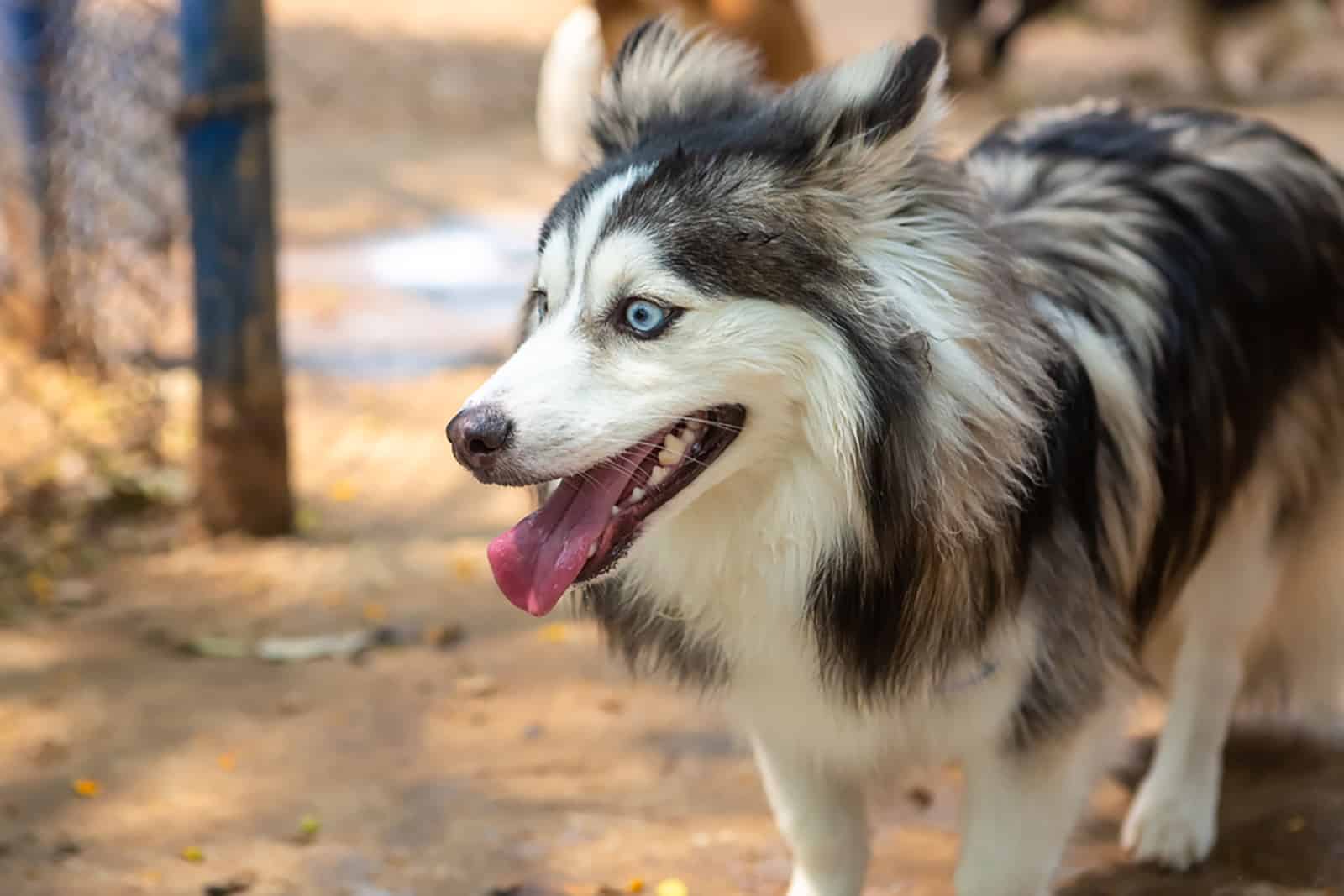
Well, a designer dog such as the Pomsky resembles both the purebred Siberian Husky parent and the purebred Pomeranian. In terms of its appearance, the Pomsky can resemble one dog parent more than the other.
If the Pomsky dog looks very much like a small Siberian Husky, or a small Pomeranian, then it will be difficult to tell if it is a mixed breed.
So, to tell if your dog is a Pomsky or not, you can compare its size to the purebred Siberian Husky’s or the purebred Pomeranian’s size.
As the Siberian Husky growth chart implies, these medium-sized fluffy dogs typically stand between 20 to 23 inches tall and weigh up to 60 pounds.
Bear in mind that male and female Siberian Huskies don’t reach the same height or weight (males are larger).
On the other hand, the Pomeranian growth chart describes the Pomeranian as a small dog that typically stands between 12 and 15 inches tall and weighs up to 30 pounds (possibly even less for the toy or teacup varieties).
If you own a Pomsky, it should look like one of those mini wolf-like dog breeds. The purebred Siberian Husky already looks wolfy, so the Pomsky may resemble a small Husky.
The Pomsky looks like a small Husky, but it is larger than your average Pomeranian.
See Also: Pomsky Growth Chart: The Definitive Pomsky Size Guide
What Colors Do Pomskies Come In?
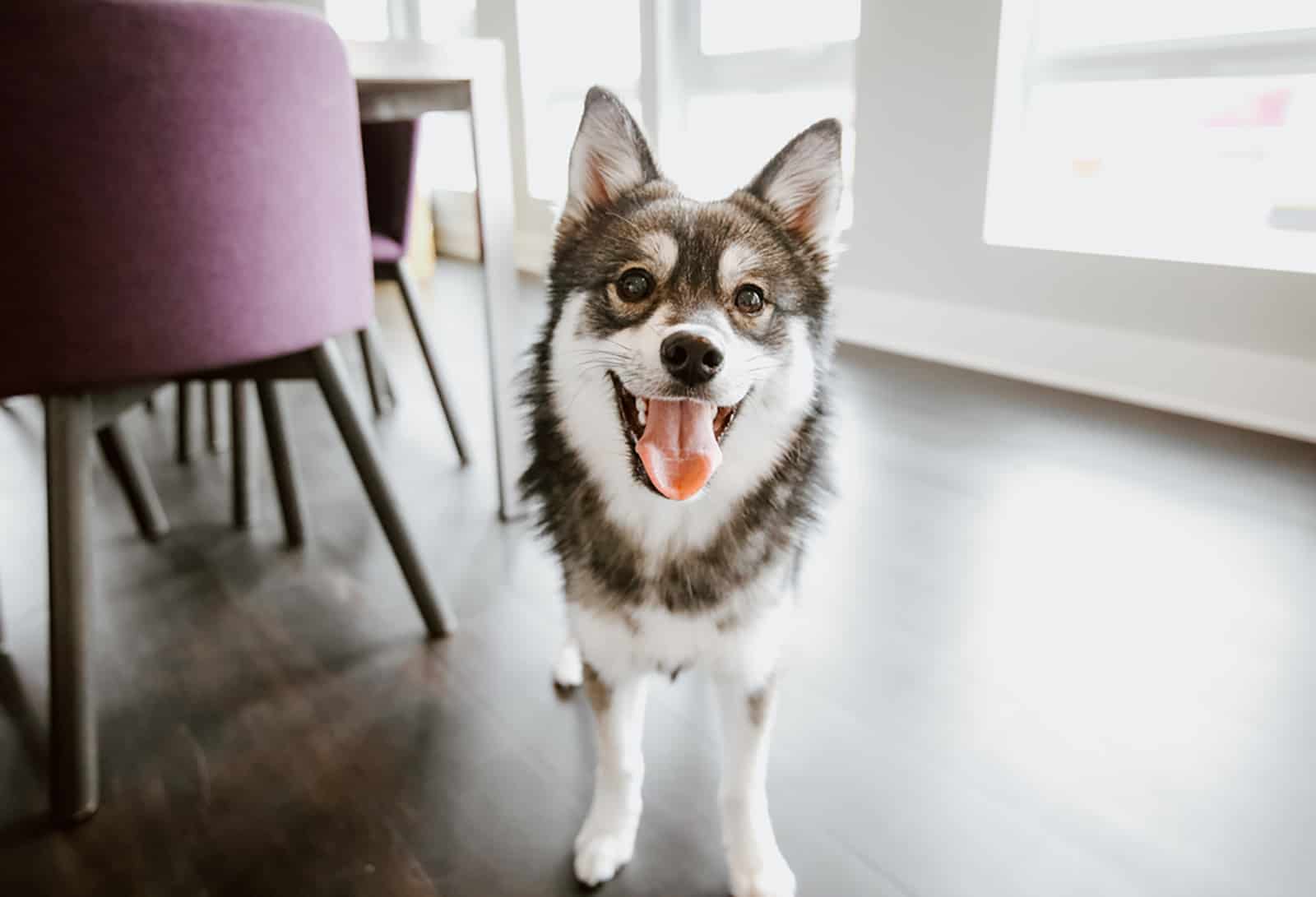
Now, let’s get to the fun part. We have already said that the parent breeds of the Pomsky are two beautiful purebred dogs — the Siberian Husky and the Pomeranian.
When we take each parent breed separately, we can see that both come in a variety of colors.
For example, Pomeranian colors count more than 25 shades and patterns, while there are over 15 beautiful Husky colors.
This means that Pomeranian Husky mix puppies come in well over 30 coat colors! The best thing about Pomsky coat colors is that each Pomsky puppy inherits a unique pattern.
The Pomsky breed comes in a variety of colors starting from black and white, gray, brown, blue, red to cream, or even pure white!
It all narrows down to mix and match — if you have an agouti Husky and mix it with a black and white Pomeranian, chances are the Pomsky is going to be both agouti and black/white!
What Are The Most Popular Pomsky Colors?
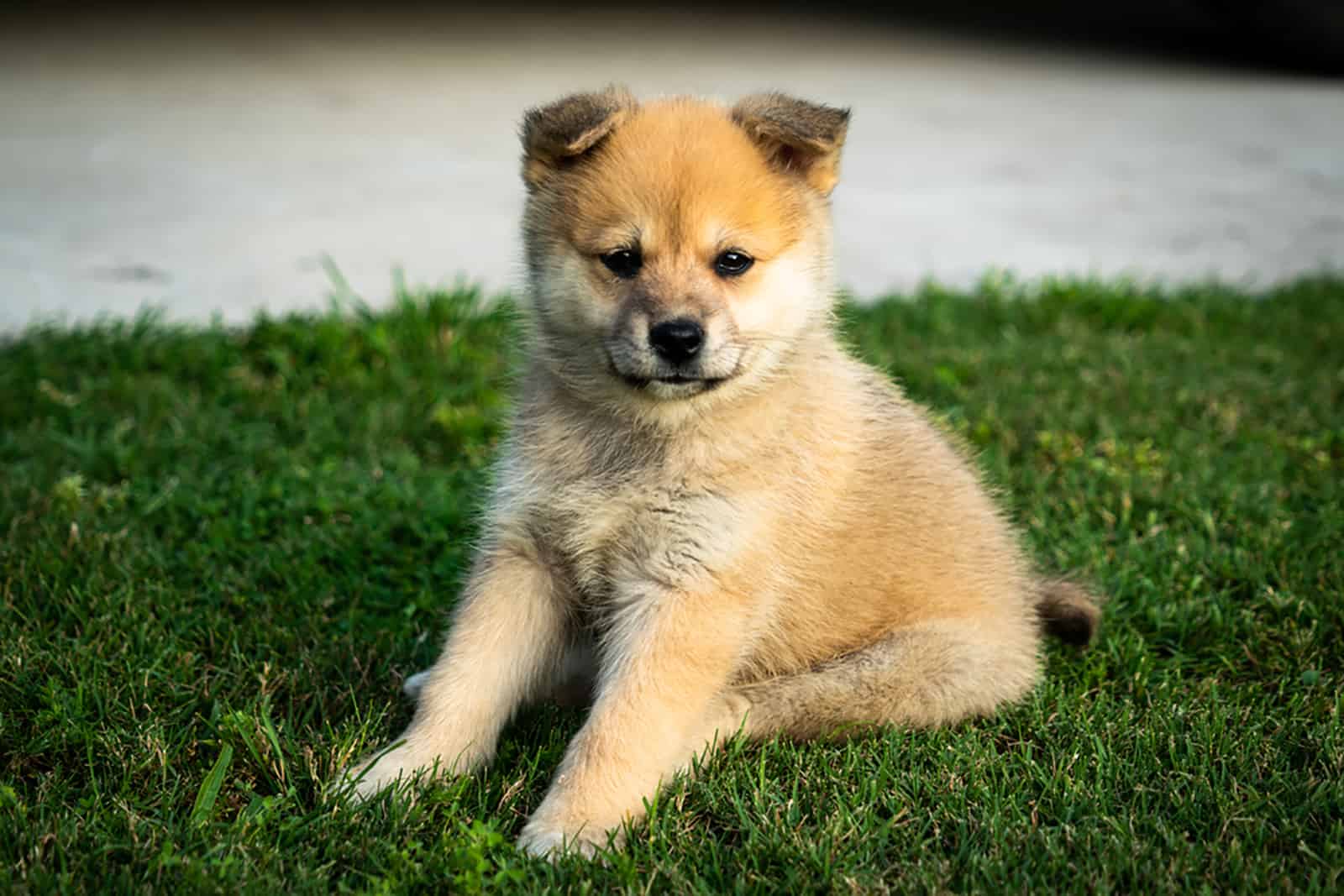
Pomsky pups are one of the most adorable dogs you will ever see! No wonder dog lovers go crazy for this hybrid breed. What makes Pomsky pups even more adorable is their coat color.
Some of the most popular Pomsky coat colors are:
• Brown
• Black and white
• Pure white
• Gray
• Red
The purebred parent breed, Siberian Husky, has distinct coat color markings: darker colors are present on its ears, forehead, and cheeks, while the middle of its face is usually in a solid white color.
The purebred Pomeranian parent breed on the other hand has similar coat color markings, but it often comes in solid coat color.
1. Brown Pomsky
If a brown Pomsky pup is born, then chances are that its Siberian Husky parent is brown and white, or its Pomeranian parent is brown.
Brown Pomsky pups are often referred to as chocolate Pomskies because their brown coat color can range from dark to light, resembling the color of chocolate.
When it comes to coat markings, the brown Pomsky usually inherits solid white patches around the cheeks and along the muzzle. Most commonly, a thin white blaze is seen across the brown Pomsky’s nose.
The inside of the brown Pomsky’s ears is white, while the outer side is colored light to dark brown.
In rare cases, brown Pomsky pups can inherit a merle coat pattern from the merle Pomeranian parent which makes them look super cute!
2. Black And White Pomsky
The black and white coat color is described in the official Siberian Husky breed standard as the standard color which means that the majority of purebred Huskies come in these shades.
I mean, when you think of a Husky the first thing that comes to your mind is a black and white one. Well, just so it happens with Pomsky pups.
Breeders often produce black and white Pomsky puppies because this coat color pattern is dominant and most of the time prevails. The black color of this Pomsky pup can come in different shades.
So, it can range from a solid jet black to a light gray color.
We will come to gray Pomskies in no time, stick around!
3. White Pomsky
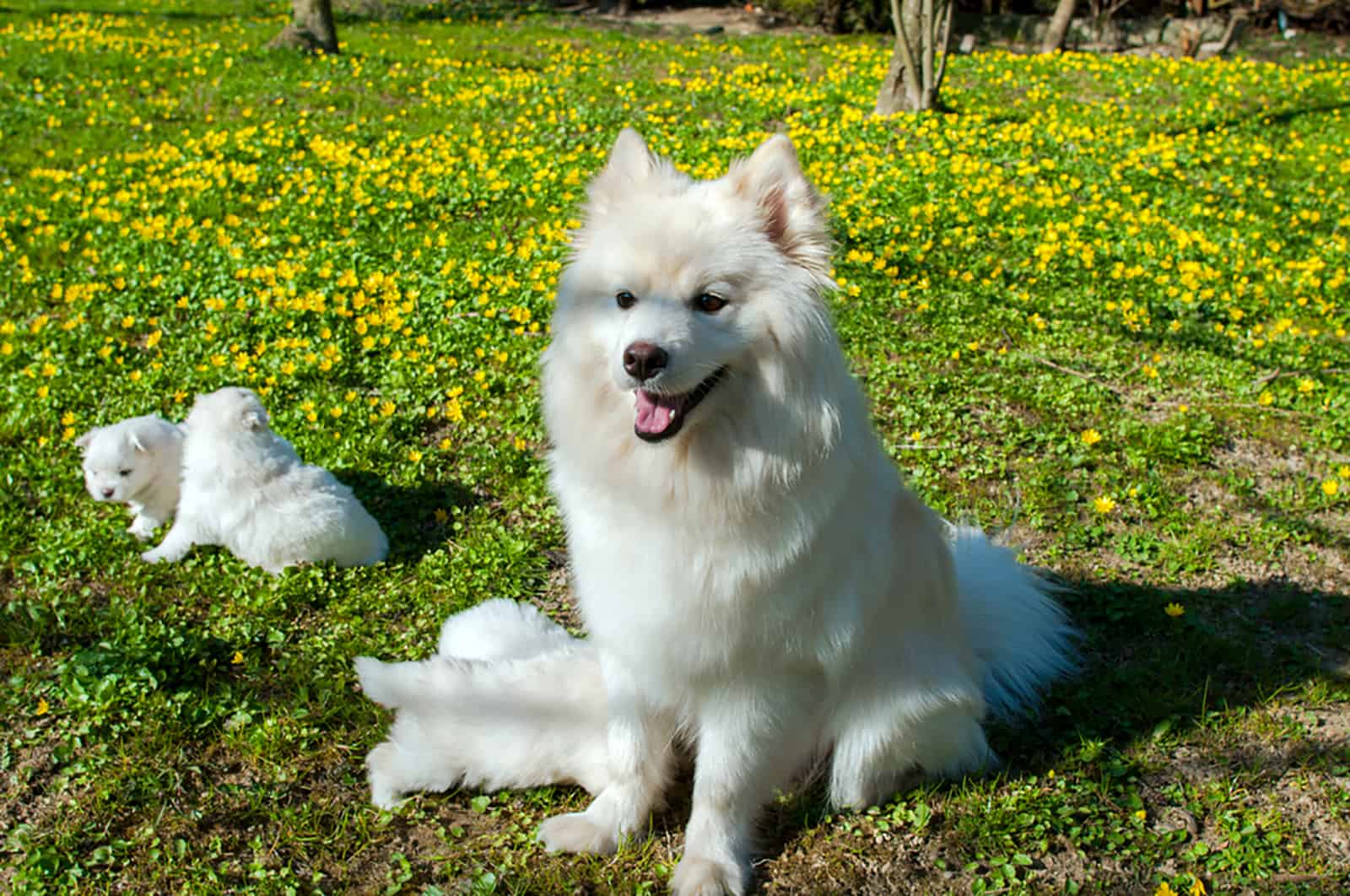
With a pure white coat color, the Pomsky is often mistaken for a purebred Pomeranian, an Alaskan Klee Kai, a Japanese Spitz, or a Samoyed! Ugh, no wonder! The white Pomsky looks like each of these popular breeds!
Sometimes the white Pomsky inherits creamy shades on its ears, around its eyes, and long its muzzle.
Even though the white coat color is carried by a recessive gene, white Pomsky puppies are frequently seen.
4. Gray Pomsky
Remember when we mentioned the black and white Pomsky? Well, the gray Pomsky is very similar, except that the black is replaced by different shades of gray. So, we might as well say that gray Pomsky puppies are gray and white.
However, the gray coat color in Pomsky pups is not like the coat color we see in gray Weimaraners. Their gray varies from darker to lighter shades because it is a dilute black.
5. Red Pomsky
Let me just say that no dog is red. The red Pomsky is a variant of brown/chocolate, with a little twist. The brown/chocolate color seems to have a reddish-chestnut shade which gives the Pomsky its “red” appearance.
In rare cases, red Pomsky puppies may inherit a different color pattern — a red merle color pattern, similar to the red merle Australian Shepherd pattern.
6. Black And Tan Pomsky
Just like the black and white variant, the Pomsky dog can inherit tan instead of white markings. Black and tan Pomsky puppies have tan markings across their chest, muzzle, ears, and on the bottom side of their tail.
Tan markings are spread across all four legs of the Pomsky.
Additionally, these fluffy dogs often have two tanned spots above their eyes — like little tanned eyebrows!
Pomsky Coat Patterns
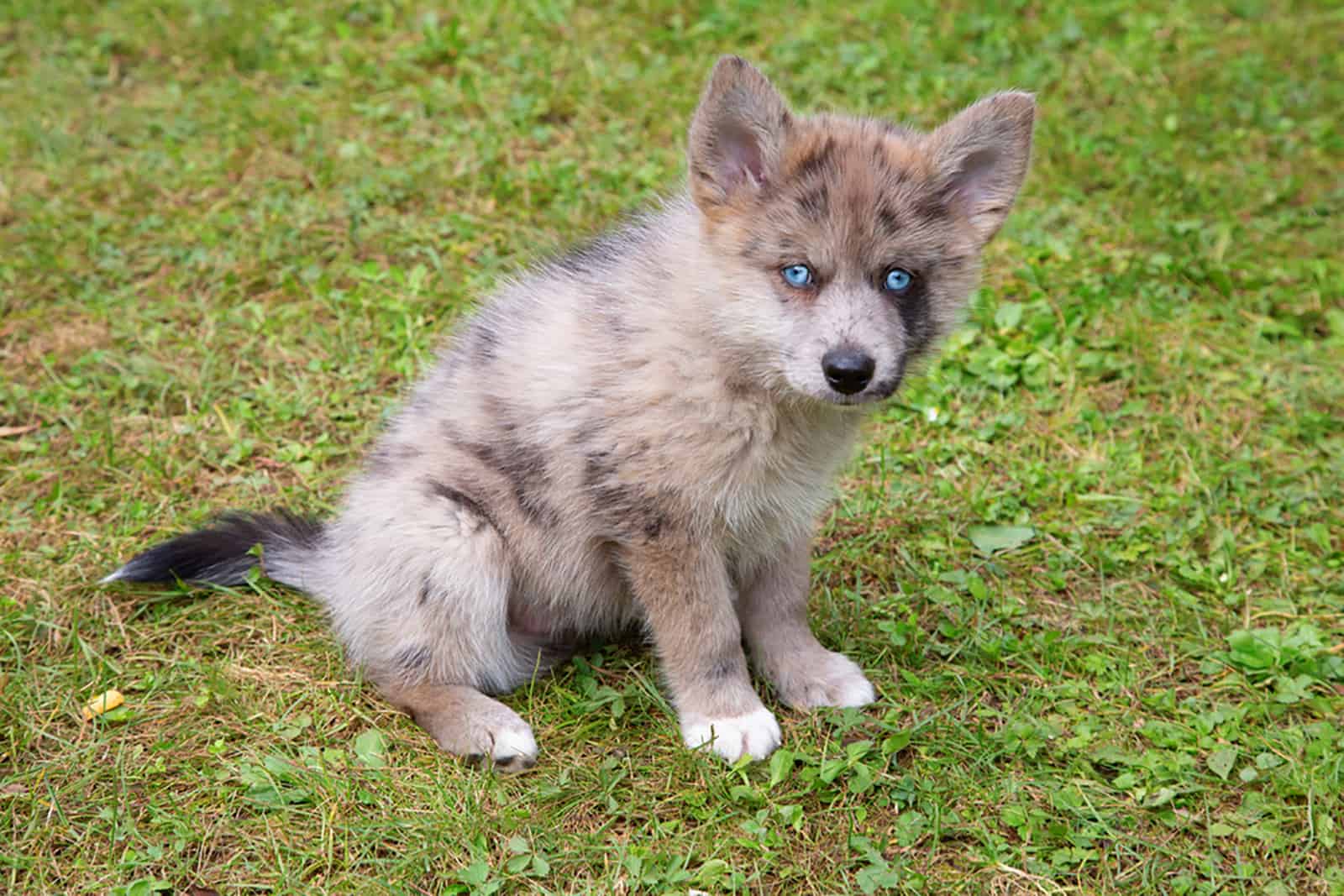
Remember when we said that Pomsky dogs rarely appear in one solid color? While Pomsky dogs have one base color, their coat can have multi-colored patterns. These include:
• Parti-merle
• Blue merle
• Red merle
• Tuxedo
• Bicolor
• Tricolor
• Brindle
• Speckled
You see, the Pomsky dog is one colorful pup! The coat color combinations are practically limitless!
Because of such a wide range of coat colors and patterns, Pomsky breeders can rarely be sure what kind of color their puppies will be!
What Is The Rarest Pomsky Color?
There are a few Pomsky coat colors that are considered rare. These coat colors include merle patterns and the blue dilute shade.
The blue Pomsky color is carried by a recessive dilute gene which makes these dogs very rare. The blue Pomsky dog is nothing more than a diluted black Pomsky dog. Yep, the “blue” Pomsky coat color derives from a diluted black pigment.
The dilute gene causes eumelanin (black pigment) to lighten while pheomelanin (red pigment) essentially stays the same.
Pomeranian or Siberian Husky dogs that carry this dilute gene frequently experience color dilution alopecia (CDA).
This skin condition results in patches of thinning or lost hair and may also include flaky and/or itchy skin.
Pomsky Eye Colors
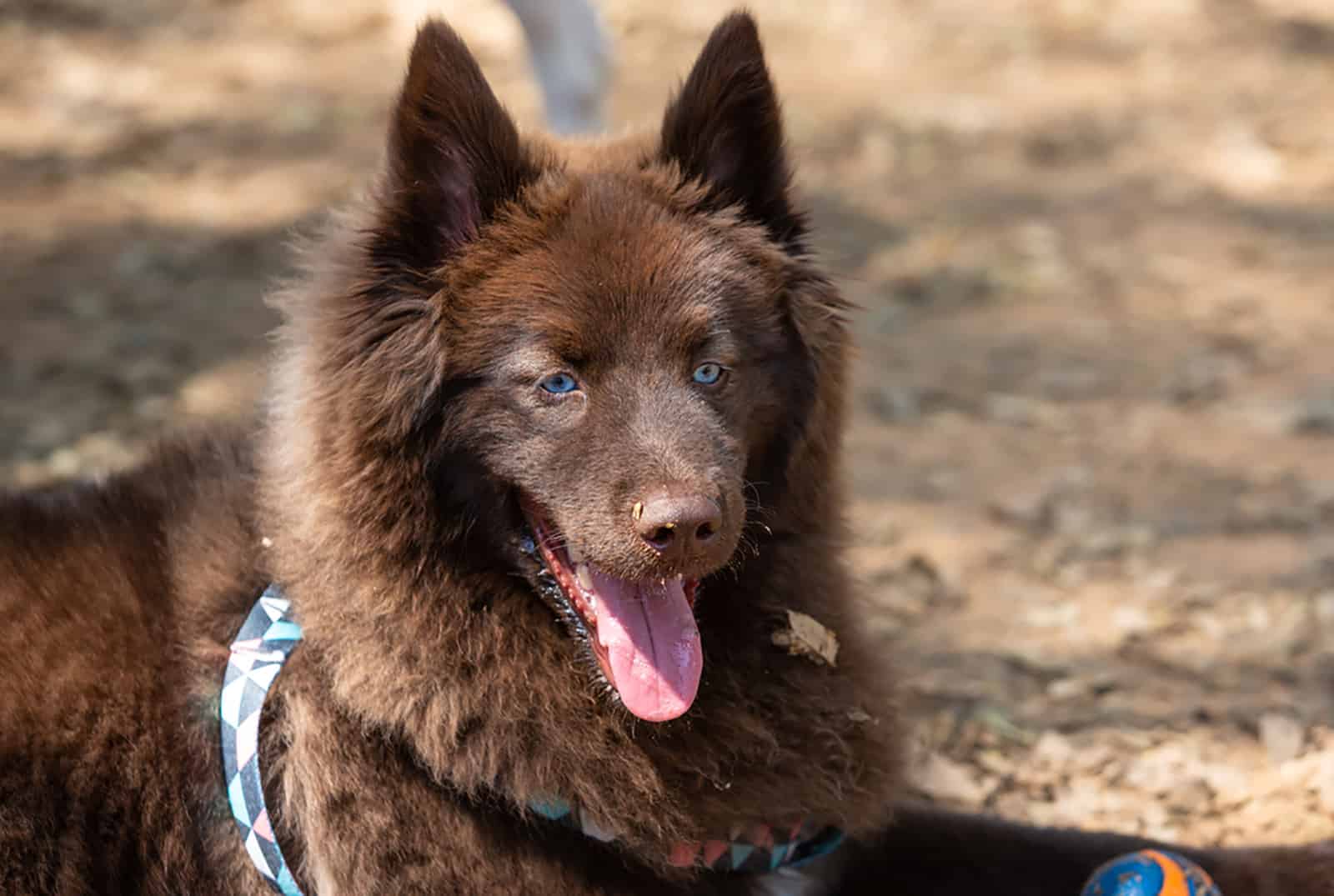
Besides beautiful coat colors, the Pomsky breed is known for its mesmerizing eyes. When we look at the parent breeds, both the Siberian Husky and the Pomeranian have beautiful, almond-shaped eyes that make you fall in love with them.
Each Pomsky dog can inherit eye colors such as:
• Blue
• Brown
• Hazel
• Green
• Parti
Do All Pomsky Have Blue Eyes?
The Pomsky is often recognized as one of the blue-eyed dog breeds, but it can inherit many more colors. But, not all Pomskies inherit blue eyes.
All Pomsky puppies will have blue eyes in the first few weeks of life, but they will change color as the puppies grow.
The Husky parent breed is known for its blue eyes, so yes, the Pomsky often inherits blue eyes. But, Husky eye colors are more than just blue shades! The Pomsky can inherit green and even parti-colored eyes from its Husky parent!
On the other hand, the Pom parent breed often has brown to hazel eyes which the Pomsky offspring can also inherit.
Pomsky Coat Type
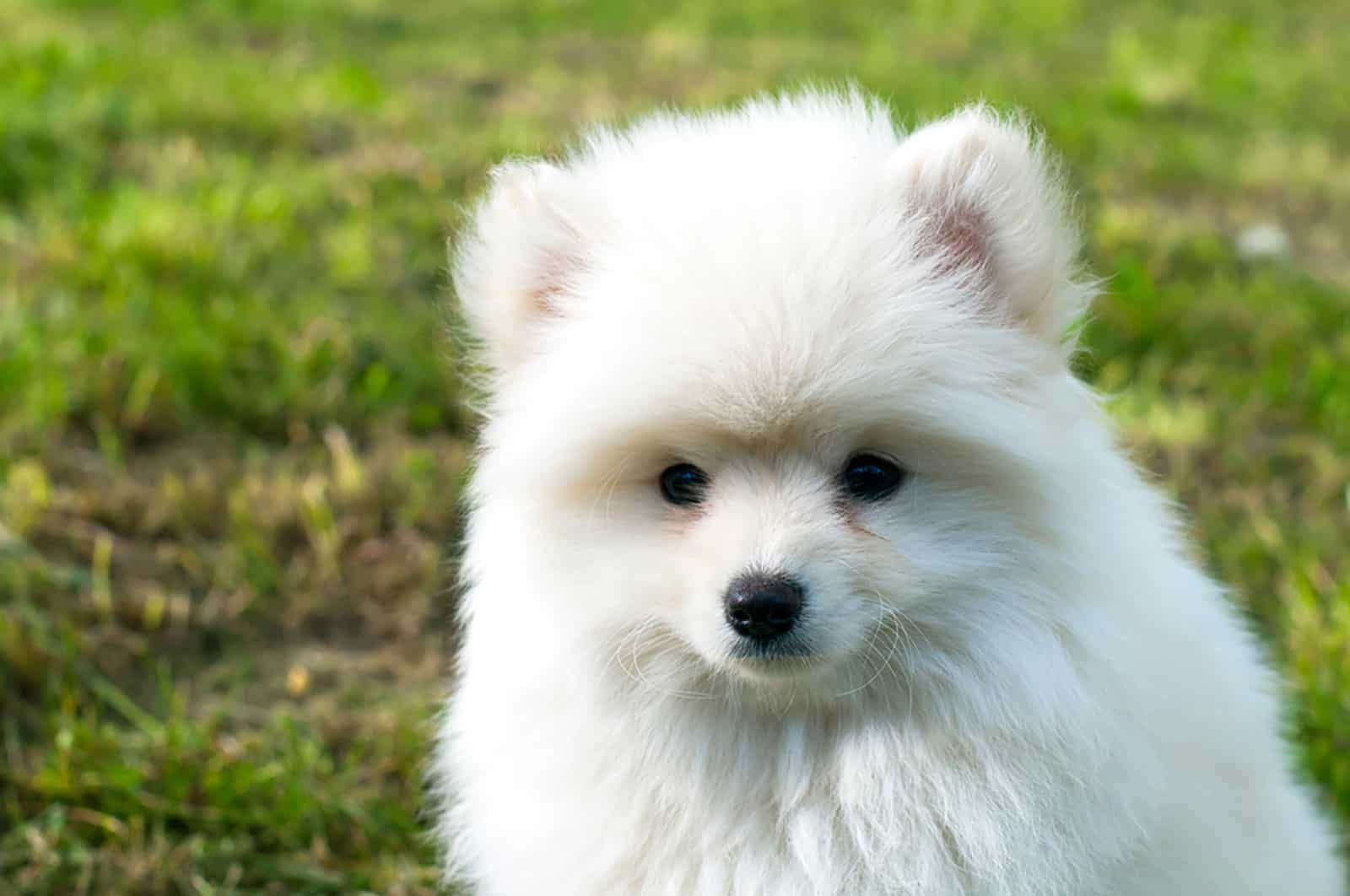
Moving on to the fluffy Pomsky coat type. Yes, it is very fluffy!
The Pomsky puppy has a double coat that is pretty thick and warm. It keeps this little designer dog warm during cold weather, but it also keeps it cool during warm weather — it is like two-in-one thermoregulation!
It has self-cooling and self-warming properties.
The Pomsky has a thick undercoat that is usually lighter in color than the outer coat. Guard hairs are often colored in a darker color than the rest of the Pomsky’s fur.
An interesting thing about the Pomsky breed is that its coat can come in different coat types:
• Plush
• Standard
• Short-haired
• Wooly
The two most sought-after Pomskies are those with plush and wooly coat types.
The plush Pomsky coat type is shorter than the wooly coat, but it has the same density and thickness.
Although it can be a similar length to the typical coat, it is fluffier in texture and has long hairs on all four limbs, the tail, around the neck, on the ears, and on the head.
These two are the fluffiest version of first-generation Pomskies — the wooly Husky and the soft Pomeranian combination is a jackpot!
The majority of plush and wooly Pomsky puppies have the same markings as the Siberian Husky parent breed.
Pomsky Shedding Amounts
I believe that many dog lovers and aspiring Pomsky owners want to know how much this fluffy puppy sheds.
Well, if we are talking about the first generation (F1) Pomeranian, then chances are 50:50 that this puppy will shed as much as the Siberian Husky parent. And we all know how much a Siberian Husky sheds (a lot!).
How much a Pomsky puppy sheds also depends on which coat type it inherited. For example, the wooly Pomsky is known to shed less than the plush Pomsky.
Taking into consideration that the Siberian Husky is a heavy shedder, the Pomsky will probably need professional grooming sessions. It will blow its coat at least two times per year — spring and fall.
Having said that, the Pomsky is a heavy and seasonal shedder that is far from being a hypoallergenic dog. With all that hair and dander, the Pomsky does not fall under the hypoallergenic dog category.
So, if you are suffering from dog allergies, you should search for a hypoallergenic breed like the Shih Tzu.
How To Keep Pomsky Coat Healthy
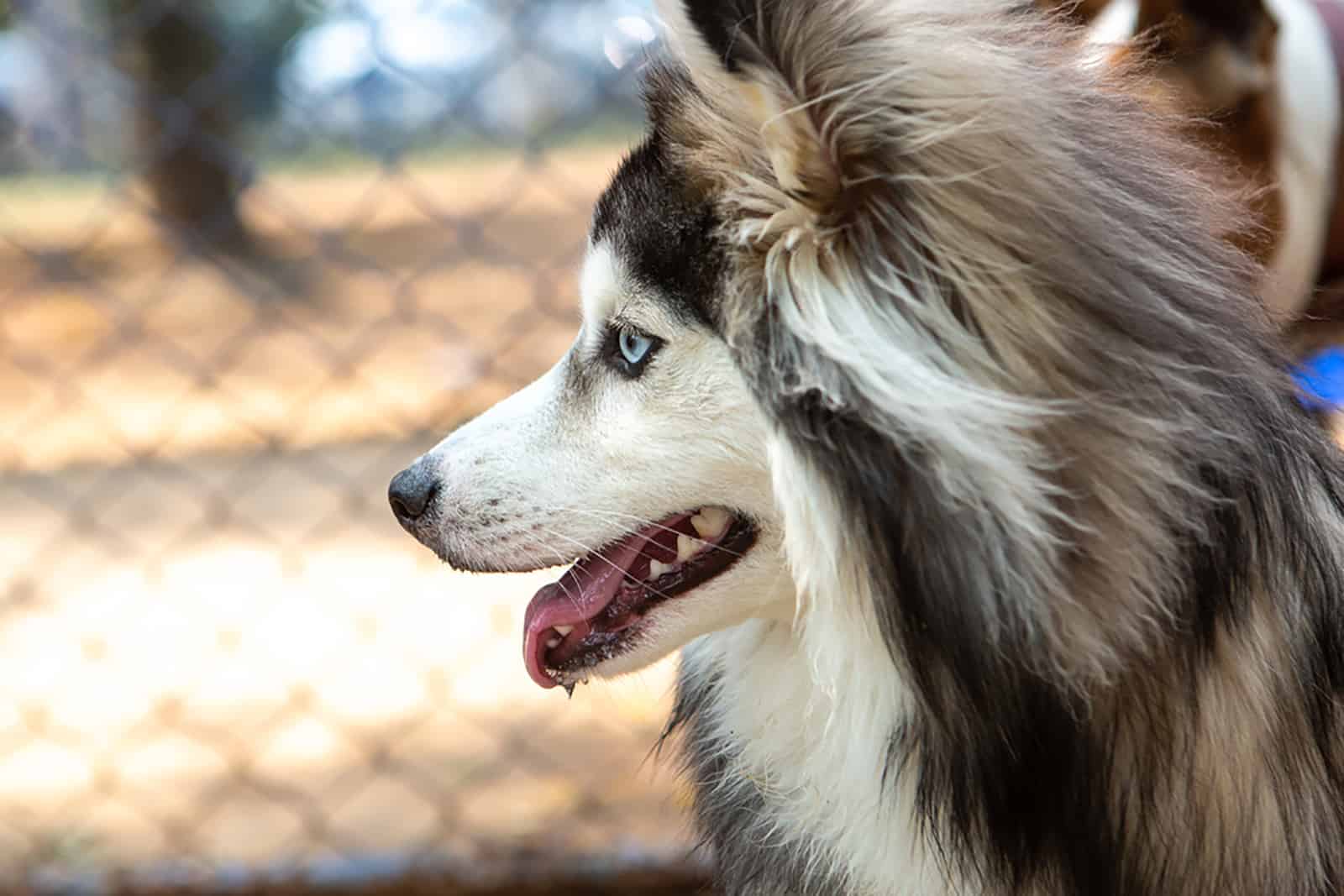
With all this shedding in mind, we have to talk about keeping Pomsky’s coat healthy and your house hair-free! Well, it will never be hair-free with a Pomsky! But, don’t confuse Pomsky’s heavy shedding with excessive shedding and hair loss.
The coat and skin appearance of a healthy pup is a sign that all is well with its overall health. A brittle and dry coat, in combination with flaky skin, is often a sign that the Pomsky needs a vet health check and a change of diet.
Here is how to keep your Pomsky’s coat and its general health in tip-top condition!
Feed Your Pomsky A Proper Diet
You know the saying “you are what you eat?” Well, your Pomsky is what it eats. Whatever your Pomsky pup ingests will show on its skin and coat.
A proper diet for the Pomsky breed consists of healthy protein, fatty acids, vitamins, minerals, and healthy carbs.
When it comes to maintaining a healthy Pomsky coat, the biggest focus should be on feeding it healthy fatty acids. These include omega-3 and omega-6 fatty acids that derive from fish oil and animal fat.
That said, Pomsky dog owners should choose the best dog food for Pomeranian dogs or Siberian Huskies because it is rich in previously mentioned ingredients.
It is highly recommended to avoid bad dog food brands because they do not hold sufficient nutritional value for the Pomsky pup.
The Pomeranian feeding chart can tell you a lot about how to properly feed a Pomsky pup.
If the Pomsky leans more towards the Siberian Husky parent in terms of size and appearance, then new owners should follow the Siberian Husky feeding chart to plan a good feeding schedule.
Include Healthy Supplements To Pomsky Diet
If you think that the diet you are feeding your Pomsky is not enough to keep its coat shiny, then you will want to incorporate some dietary supplements that contain a wide range of vitamins and minerals.
The best vitamins for a healthy Pomsky coat are vitamins D, E, K, A, C, and B12.
But, please, do not do it on your own — make sure to consult your vet before giving your Pomsky any dietary supplements.
More often than not, a well-balanced Pomsky diet provides this pooch with all necessary nutrients and it does not require any additional supplements.
This is why you have to ask your vet whether or not your Pomsky needs any dietary supplements.
Giving too many vitamins and minerals to your Pomsky is just as bad as not giving any.
Groom Your Pomsky Like A Pro
I don’t know if grooming is your favorite, or your least favorite part of owning a dog, but let me tell you that grooming your Pomsky requires patience and grooming tools!
The frequency and grooming technique depend on the coat type of the Pomsky pup.
For example, wooly Pomskies are more difficult to groom because of their thick undercoat. Plush Pomskies may be easier to groom, but they still shed quite a lot.
Investing in a good brush for Siberian Husky dogs or Pomeranians will help you win the battle with Pomsky’s thick coats.
Grooming your Pomsky will require daily brushing and detangling, as well as occasional visits to a professional groomer.
It’s better to leave your Pomsky in the hands of a professional groomer, especially during the coat-blowing period.
As for bathing, you should not bathe your Pomsky often, unless it has gotten itself into something dirty. Every one to two months is okay to bathe the Pomsky dog, and you should avoid giving it any unnecessary haircuts.
Clean Your Pomsky’s Eyes And Ears
You may think that cleaning your Pomsky’s eyes and ears has nothing to do with its coat health, but let me tell you that it has a lot to do with keeping its coat healthy.
Pomsky pups have big and shiny puppy eyes. If their eyes develop an infection and/or they start tearing, the tears can make the hair around their eyes wet and sticky. It can also lead to your Pomsky dog losing its hair around the eyes.
When it comes to ear cleaning, a bit of ear plucking and using water or special ear oil will help your Pomsky’s ears look healthy and clean.
Good eye and ear hygiene will not only improve Pomsky’s good looks, but it will also keep them healthy and carefree!
What Problems Do Pomskies Have?
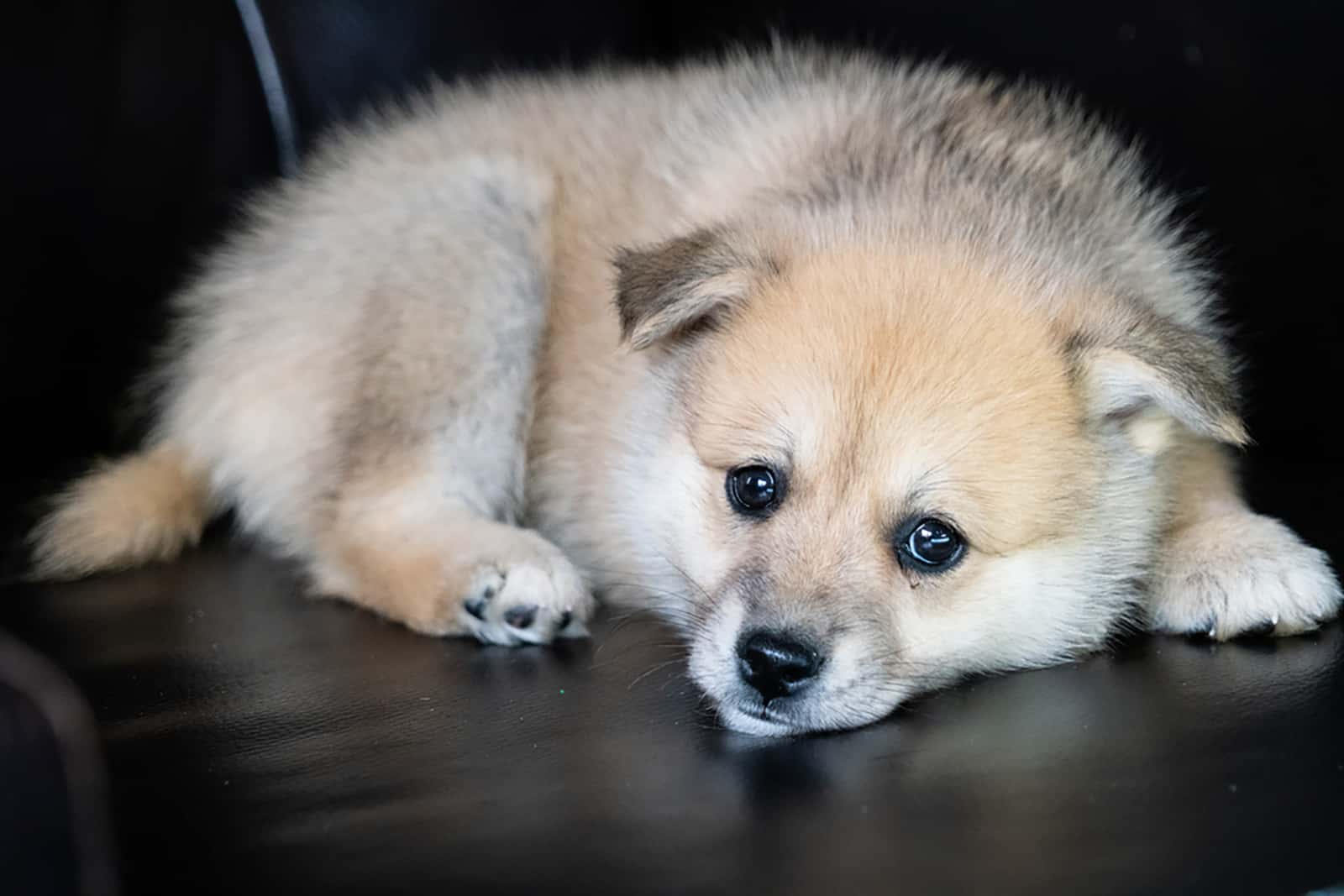
Even though it is one of the healthier mixed dog breeds, the Pomsky still inherits a bunch of breed-specific diseases from its purebred parents.
Besides the most common hereditary condition, hip dysplasia, Pomskies can inherit canine epilepsy, several heart diseases, patellar luxation, and collapsing trachea.
All of these health issues contribute to changing Pomsky’s appearance in their way. They either affect the skin, coat, or weight of the Pomsky dog.
However, there are a few breed-specific health issues linked to allergies and skin problems that affect many Pomeranian mixes, including the Pomsky breed.
Food Allergies
Food allergies are a common health issue in many dog breeds and the Pomsky is no exception. Purebred Pomeranians are prone to developing different types of food allergies that leave an effect on their skin and coat.
The Pomsky offspring often inherits these health issues which is why many owners become worried when they notice changes in their coat and skin.
If it is suffering from a food allergy, your Pomsky dog will have inflamed and itchy skin on parts where there is less hair (abdomen, ears, and between paw pads).
In addition to local skin inflammation, the Pomsky that is allergic to certain food will experience troubles with its digestive system which may result in vomiting or loose stools and diarrhea.
All of this has a great effect on Pomsky’s skin — it becomes dry and flaky. Such skin does not provide good conditions for a healthy and shiny coat. Therefore, Pomsky’s coat will also become brittle and dry, making its color dull and lifeless.
Thyroid Problems
One of the most common hormonal disorders in all dogs is problems with the thyroid gland, which affects small to medium dogs more than large ones.
While thyroid problems are mostly inherited, Pomsky dogs may acquire them throughout their lifetime.
Thyroid problems in dogs include hypothyroidism (decreased thyroid hormones) and hyperthyroidism (increased thyroid hormones).
Both types of thyroid problems change the appearance of Pomsky’s body, skin, and coat, as they interfere with normal metabolic rate.
Pomsky dogs that are suffering from thyroid problems such as hypothyroidism may experience slow hair growth, hair thinning, and even hair loss.
Zinc Responsive Dermatosis
Zinc-responsive dermatosis frequently affects dog breeds like the Siberian Husky and Alaskan Malamute. This means that the Pomsky may inherit this skin problem from its Siberian Husky parent.
The Pomsky that is suffering from this skin condition often develops dry crusts around its mouth, eyes, lips, and private parts.
Pomskies that have zinc-responsive dermatosis have dry skin that can itch pretty badly. This skin condition makes their coat dry and lifeless.
Even though Pomsky dogs ingest sufficient amounts of zinc through quality dog food and supplements, the skin condition may be caused by insufficient intestinal absorption of the zinc mineral.
Other causes of zinc-responsive dermatosis include female Pomsky dogs in heat, stress, or issues with the digestive system.
What Is The Life Expectancy Of A Pomsky?
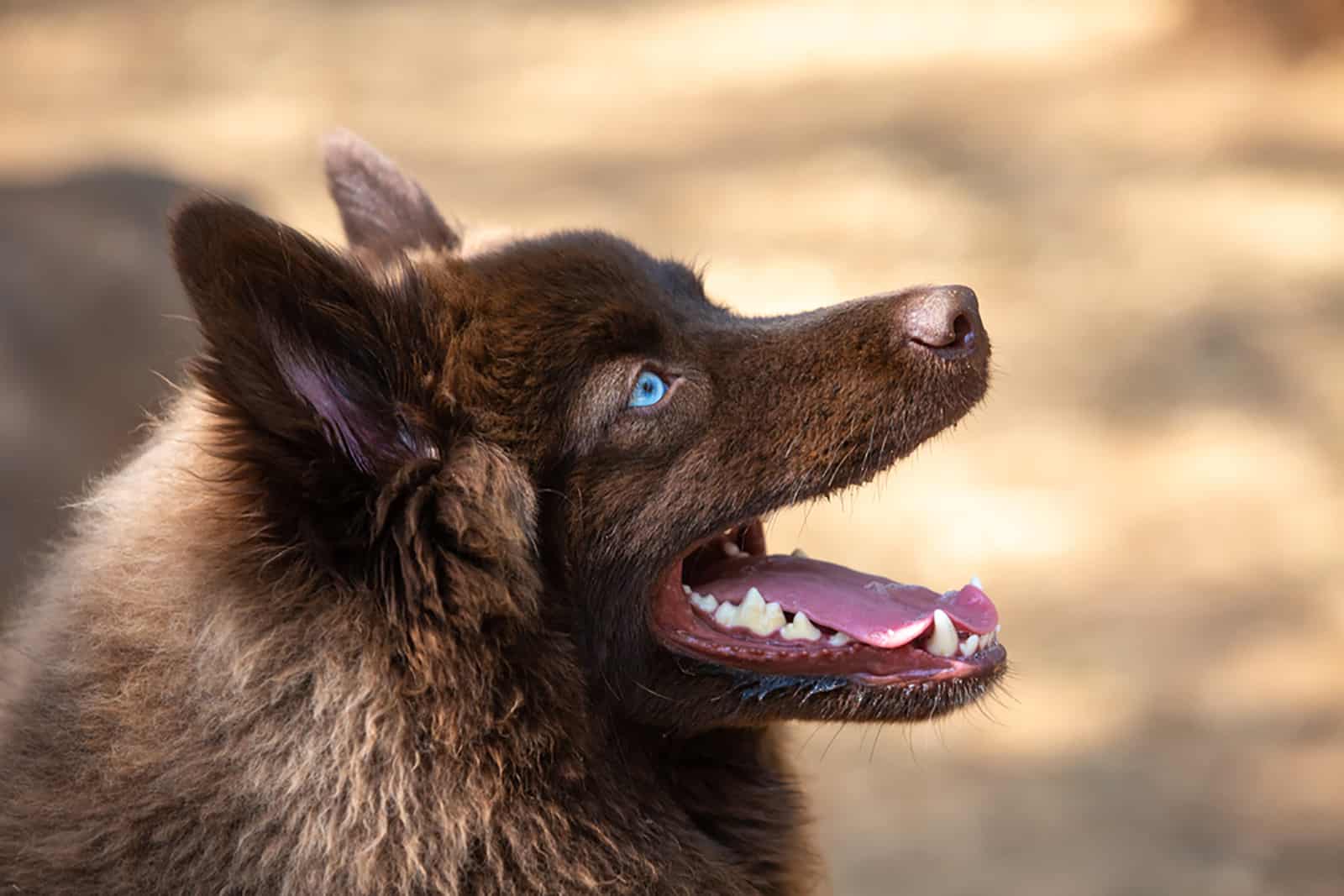
The average lifespan of a Pomsky dog is between 13 and 15 years if its health is kept in good condition.
There are lots of things that can affect the Pomsky’s lifespan, such as:
• Quality of breeding program
• Breeder’s competence
• Maintaining Pomsky’s health
• Meeting daily exercise needs
• Providing a high-quality diet
• Training and early socialization
Getting a Pomsky pup is exciting and fun, but it is a lifetime responsibility. The majority of Pomsky owners agree that these pups have high energy levels and may come out as needy!
To make your Pomsky live longer, you have to meet its needs and keep it happy and healthy all the time!
Where Can I Find A Pomsky?
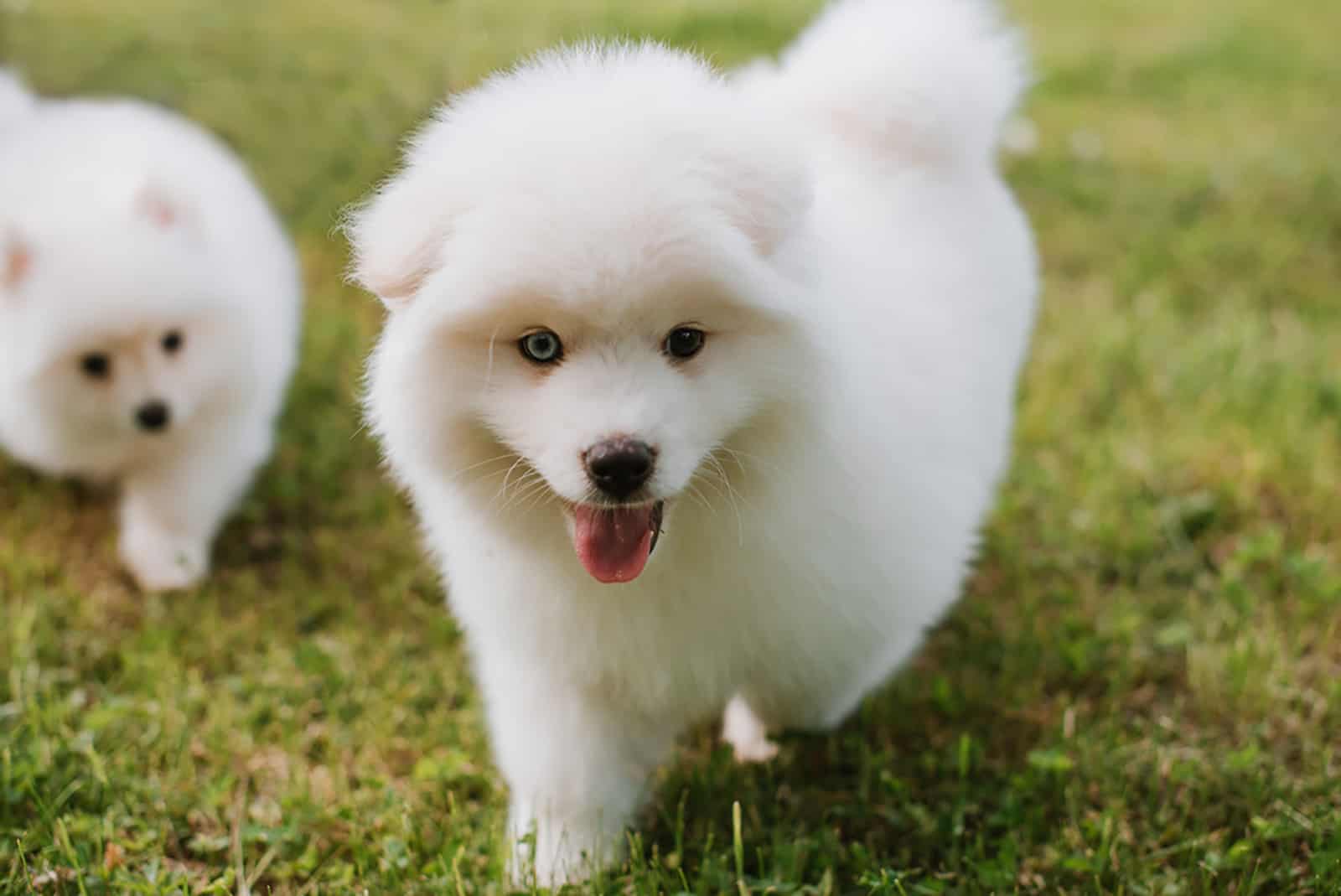
Pomsky dogs are super-famous and they can be found in a lot of places. But, just because there are many advertisements online, does not mean that each Pomsky pup is developed through ethical breeding practices.
There are many unethical breeders, puppy mills, and backyard breeders who don’t pay attention to developing healthy Pomsky pups, but rather produce more pups to get more money.
The U.S. is a huge dog marketplace that offers lots of pure breeds and crossbreeds. Pomskies can be found in every state, but not every breeder is a good breeder.
The best place to look for a Pomsky puppy is at reputable Pomsky breeders. While you may not always find a “Pomsky breeder” you will stumble upon quality Pomeranian breeders that may have some Pomsky puppies in store.
Ethical Siberian Husky breeders may also have a healthy Pomsky puppy litter, so make sure to do your research.
How Much Does A Pomsky Cost?
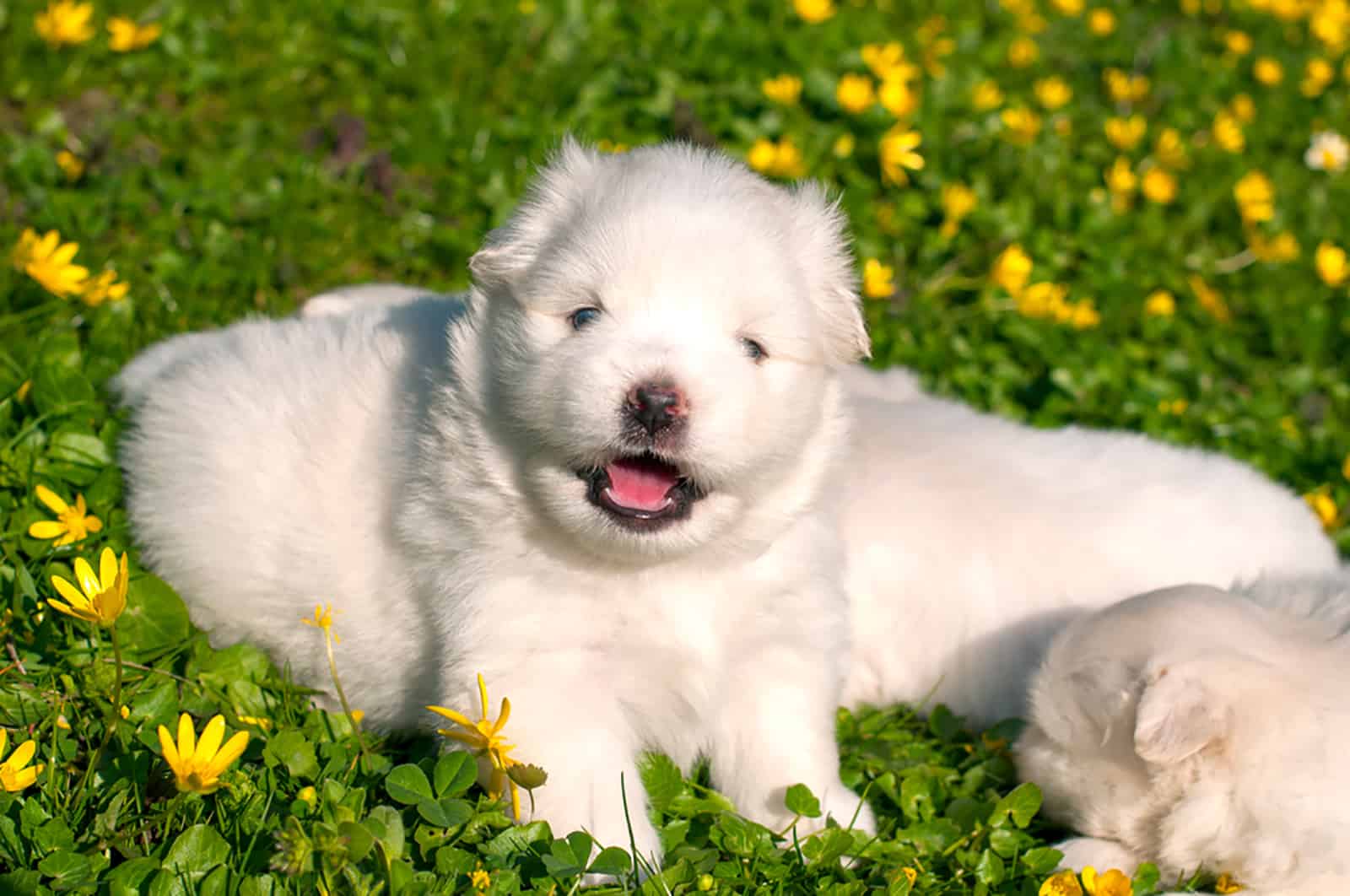
While it is not a purebred puppy, the Pomsky is one of the most expensive dog breeds. Well, at least it is one of the most expensive hybrid breeds.
Long story short — Pomsky costs between a whopping $2000 and $5000! That’s quite a lot for a crossbreed, don’t you think?
The cost of a Pomsky puppy will vary depending on the pedigree of both purebred parents, the breeding program, your location, and the breeder’s competence.
The Siberian Husky is a large breed of dog, while the Pomeranian is quite small.
That said, the major size difference between the purebred Siberian Husky and the purebred Pomeranian dog calls for artificial insemination.
This is the most common breeding practice in developing quality Pomsky puppies and it affects the overall price of each puppy.
Since the Pomsky is not accepted by the American Kennel Club (AKC) because it is a hybrid breed, it can not participate in dog shows or be registered with the AKC or any other major kennel club.
Conclusion
The Pomsky is the type of dog you would see and go “aww!”
Due to its popularity and high demand, we might as well say that the Pomsky is the most successful designer breed in the U.S.
Pomsky breeders really have their hands full with producing the healthiest and the most beautiful puppies!
Even though many dog lovers don’t choose their pup based on coat color, many aspiring dog owners still want to choose between many Pomeranian colors. Some want their Pomsky to be brown, while others wish it would be black and white.
No matter which one of the beautiful Pomeranian colors you choose, it is crucial to keep your new Pomsky pup as healthy as it can be!
Only a healthy Pomsky puppy develops a shiny and vivid coat, which enhances its color!
Related Content
Cocker Spaniel Colors: How Many Shades Are There?
